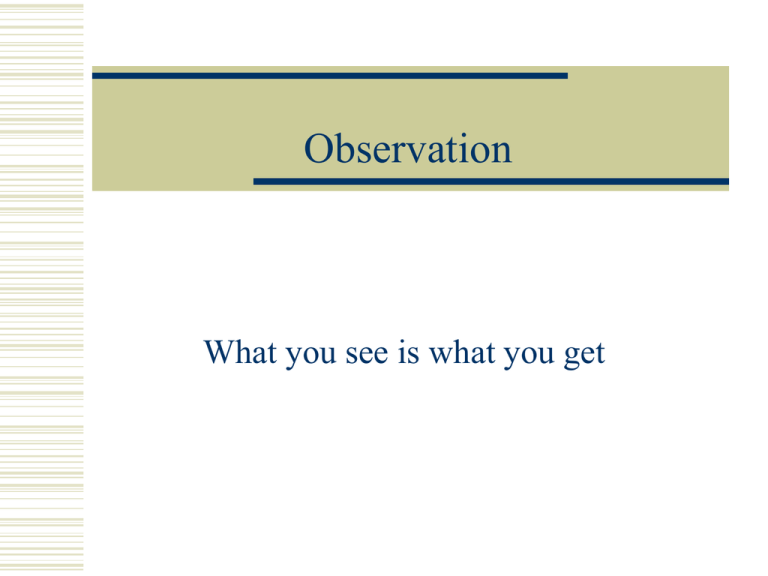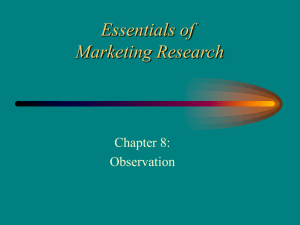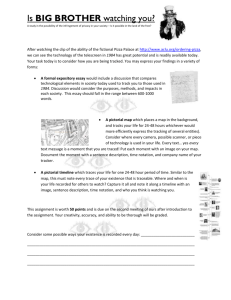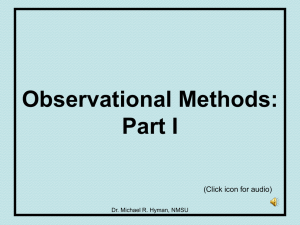Observation What you see is what you get
advertisement

Observation What you see is what you get Observation Research Defined Observation research can be defined as the systematic process of recording the behavioral patterns of people, objects, and occurrences without questioning or communicating with them. Observational Situations Situation Example People watching people Observers stationed in supermarkets watch consumers select frozen Mexican dinners. The purpose is to see how much comparison shopping people do at the point of purchase. People watching phenomena Observer stationed at an intersection counts traffic moving in various directions. Machines watching people Move or videotape cameras record behavior as in people-watching-people example. Machines watching phenomena Traffic-counting machines monitor traffic flow. What can be observed Human behaviour and physical actions Verbal behaviour Expressive behaviour Spatial relations and locations Temporal patterns Physical objects Verbal or pictorial records WHAT CAN BE OBSERVED Phenomena Example Human behavior or physical action Shoppers movement pattern in a store Verbal behavior Statements made by airline travelers who wait in line Expressive behavior Facial expressions, tone of voice, and other form of body language WHAT CAN BE OBSERVED Phenomena Example Spatial relations and locations How close visitors at an art museum stand to paintings Temporal patterns How long fast-food customers wait for their order to be served Physical objects What brand name items are stored in consumers’ pantries Verbal and Pictorial Records Bar codes on product packages Approaches – Natural versus contrived situations. – Visible/open versus disguised/hidden situations. – Structured versus unstructured observation. – Human versus machine observation. – Direct versus indirect observation. Advantages and Disadvantages of Observation Research Advantages – Observation research provides the researcher the opportunity to watch what people actually do rather than relying on reports of what they say they do. – This approach can avoid much of the biasing factors caused by the interviewer and question structure associated with the survey approach. •Communication with respondent is not necessary •Data without distortions due to self-report (e.g.: without social desirability) •Bias •No need to rely on respondents memory •Nonverbal behavior data may be obtained •Certain data may be obtained more quickly •Environmental conditions may be recorded •May be combined with other methods to provide supplemental evidence Disadvantages – Only behavior and physical personal characteristics can usually be examined. The researcher does not learn about motives, attitudes, intentions, or feelings. – Observation research can be time consuming and costly if the observed behavior occurs rather infrequently. – Interpretation of data may be a problem – Possible invasion of privacy Who sees what where… Humans observing Humans Mystery Shoppers – People employed to pose as consumers and shop at the employer’s competitors to compare prices, displays, and the like. One-Way Mirror Observations – The practice of watching unseen from behind a one-way mirror. Shopper Patterns – Drawings that record the footsteps of a shopper through a store. Response latency – Recording the decision time necessary to make a choice between two alternatives. Test sites Humans observing Physical Objects Content Analysis –A technique used to study written material (advertising copy, newspapers, minutes) by breaking it into meaningful units, using carefully applied rules. Physical trace evidence –Study of visible signs of past event/occurrence. –garbology Physical Audit –The examination and verification of the sales of a product. –Pantry audits Machine Observing People Electroencephalogram (EEG) – A machine that measures the rhythmic fluctuations in electrical potential of the brain and can be used to measure an individual’s emotional response to a stimulus. Eye tracking monitors – Record how subject reads or views phenomenon Pupilometer – Observes and records changes in the diameter of subjects pupils which changes as a result of cognitive processing Psychogalvanometer – Measures Galvanic Skin Response (GSR)involuntary changes in the electrical resistance of the skin Voice pitch analysis – Measures emotional reactions through physiological changes in voice Machine Observing Phenomenon Traffic counters – Machines used to measure vehicular flow over a particular stretch of roadway. People meter – A microwave computerized rating system that transmits demographic information overnight to measure national TV audiences. Scanner based research – A system for gathering information from a single group of respondents by continuously monitoring the advertising, sales, promotion, and pricing they are exposed to and the things they buy.




